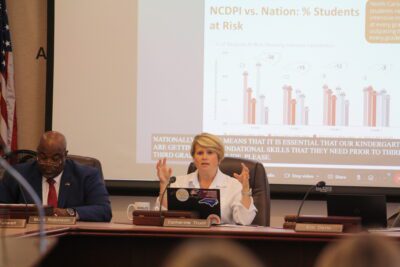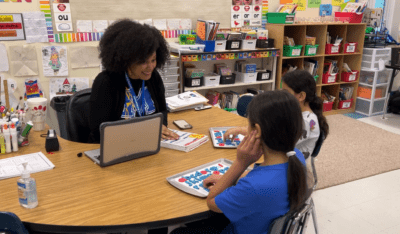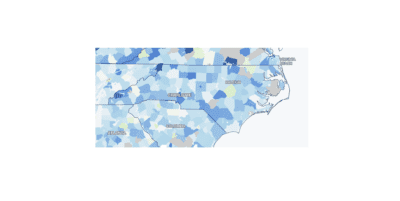
|
|
North Carolina students are continuing, on average, to increase end-of-grade (EOG) test scores since pandemic lows in 2021, according to new recovery data presented to the State Board of Education last week.
In 2021, state test scores decreased across all test subjects and levels, with the exception of English II, which increased. During the 2023-24 school year, most test subjects and levels have increased in the right direction, though most are still lower than before the pandemic. Scores in Reading 4, 7, and 8 as well as Science 8 have decreased slightly since 2021.
“This data allows us to answer the question, ‘when will we recover?'” Dr. Andrew Smith, deputy superintendent in Department of Public Instruction’s (DPI) Office of Innovation, told the Board. “… In a post-ESSER world, with limited resources for intervention, we think this model helps leaders make good, data-informed financial decisions as well.”
During the height of the pandemic, states received nearly $122 billion in Elementary and Secondary Schools Emergency Relief (ESSER) funds to address student academic, social, emotional, and mental health needs. North Carolina received $3.6 billion, on top of previous federal Covid relief dollars.
The deadline to spend those funds was Sept. 30, 2024.
Since 2021, the General Assembly has appropriated funds to DPI to partner with SAS to fund learning recovery analysis, along with student projections compared to pre-pandemic expected performance.
That same year, state Superintendent Catherine Truitt created DPI’s Office of Learning Recovery, which according to its website, “provides the research and support needed to make evidence-based decisions to combat learning loss and accelerate learning for all students.”
Every year since 2021, the Office of Learning Recovery, in partnership with the EVAAS (Education Value-Added Assessment System) Team at SAS, has released state-level recovery reports.
Last week, DPI staff said that future recovery analysis work will include getting district-level data into the hands of local leaders, and then trying to disaggregate data. However, last week was Truitt’s last Board meeting as superintendent. It remains to be seen how Superintendent-elect Mo Green will continue learning recovery analysis and efforts moving forward.
Below you can find an overview of the recovery trends presented by DPI. First, here’s a look at the categories included in the graph:
DPI’s presentation to the SBE
- Pre-Pandemic Trend represents the overall trend in achievement for an assessment between 2013 and 2019. This line smooths out the year-to-year variation in the observed achievement for the district and the state.
- Pandemic Impact represents the extent to which actual achievement in 2021 diverged from the pre-pandemic trend, had it continued to 2021. This line represents a counterfactual, or an estimate of what achievement might have been if the pre-pandemic trend had continued to 2021.
- Post-Pandemic Trend represents the overall trend in achievement for an assessment between 2022 and 2024. This line smooths out the year-to-year variation in the observed achievement for the district and the state.
- Distance to a Full Recovery represents the extent to which actual achievement in 2024 diverged from a full recovery according to the threshold. There are two ways to consider recovery: a continuation of the pre-pandemic trend based on the 2013-2019 timeframe or a three-year threshold representing the more immediate time frame of 2017-2019.
“This is a more robust way to measure trends than simple pre/post comparison of district averages,” DPI’s presentation says. “The model considers trends in achievement prior to the pandemic.”
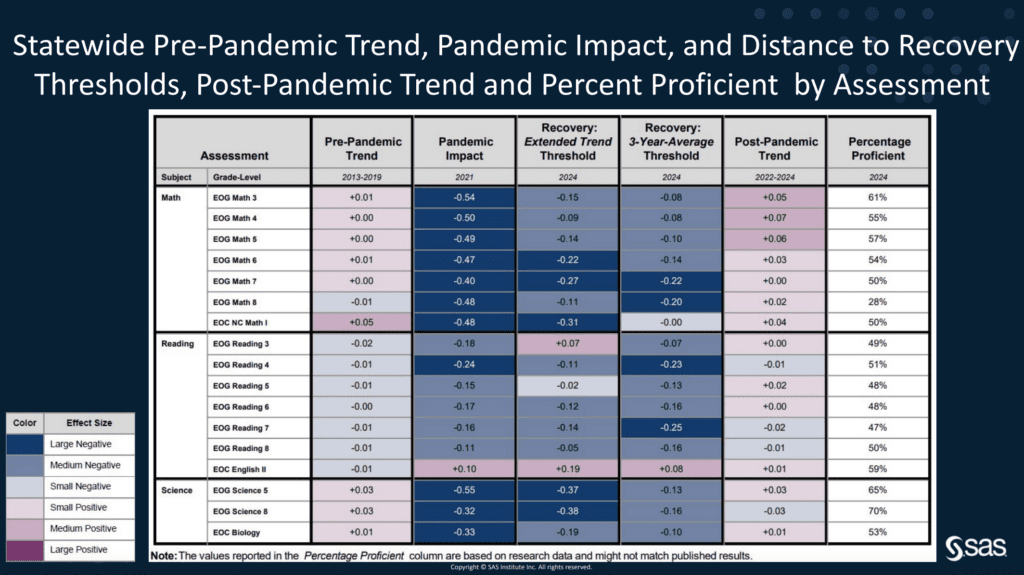
Dr. Jeni Corn, the former director of research and evaluation in DPI’s Office of Learning Recovery and Acceleration, told the Board the most concerning trends are in Reading 7 and 8, and Math 7 and 8. Though Math 7 and 8 have remained flat or slightly increased, they have done so at smaller rates than other math levels.
Trends in Reading 4 and Science 8 need further analysis, Corn said, to know what is leading to the decreases in average scores in comparison to other cohorts.
Moving forward, DPI should work to help target interventions for chronically absent students, Corn said, and focus on targeted and evidence-based interventions for middle schoolers. Several Board members said that middle schoolers sometimes struggle to connect the real-life application of what they learn, in a way that elementary and high school students do not.
“I think North Carolina has some work to do to figure out how to better support middle schools and their teachers and students,” Corn said.
While the state continues to work toward recovery, Corn said North Carolina should also celebrate early grades literacy and math progress. Specifically, Corn and Board members cited the literacy skills made by K-3 students since science of reading implementation officially began during the 2021-22 school year.
On Thursday — during her last Board meeting — DPI surprised Truitt by naming her as “the trailblazing champion” in implementing the science of reading across North Carolina public schools.
“…It took a courageous leader with a consistent message and the ability to drown out the background noise, remaining steadfast and bold, even when others initially pushed back. The Office of Early Learning would like to recognize state superintendent Catherine Truitt as North Carolina’s trailblazing champion for her for her leadership and commitment to turn a plan into action for over 44,000 educators and every student that they taught and will continue to teach for years to come.
…She is North Carolina’s testament to the fact that leadership indeed does matter.”
Dr. Amy Rhyne, senior director of DPI’s Office of Early Learning
Board Chair Eric Davis also thanked Truitt for her service.
“I’d like to thank our superintendent, who for the last four years, we worked together to do good things for our kids,” Davis said. “And whether it was science of reading, the literacy gains, whether it’s improved standards, whether it’s having advisors that bring to us the perspective of principals and teachers and so forth — big things and small things — we all owe a huge debt of gratitude to Superintendent Truitt.”
For her part, Truitt praised the efforts of North Carolina teachers and students, while also pointing to the work ahead. This school year is the first that all early literacy teachers have received science of reading training, she said.
Moving forward, Truitt said DPI must continue to support local districts as the implement high-quality training and curriculum.
“We are going to see the trends continue in the right direction — I have no doubt about that,” she said. “But it is going to take a couple of years for all students to realize the investments of time and money.”
You can read DPI’s full presentation on learning recovery here.
Student health and school mental health plans
Last week, the Board also received an overview of data collected for the Healthy Active Children and School Mental Health reports.
Every school district is required to submit its Healthy Active Children Policy to DPI by Sept. 15 every year. Among other things, the summative report of district policies includes information regarding School Health Advisory Councils, minutes of physical activity, minutes of physical education, recess, and trend data since the 2003-2004 school year.
The report, which covers results from the 2023-24 school year, also includes data collected for the School Mental Health Report.
Here are highlights from the report, as presented by DPI:
- 98% of LEAs Responded (113/115)
- 56% of School Health Advisory Councils met at least quarterly
- 73% of School Health Advisory Councils provide annual reports to their local Board of Education
- 61% of schools provided staff wellness programs
Here’s a look at what survey data showed about access to physical and health education for students.
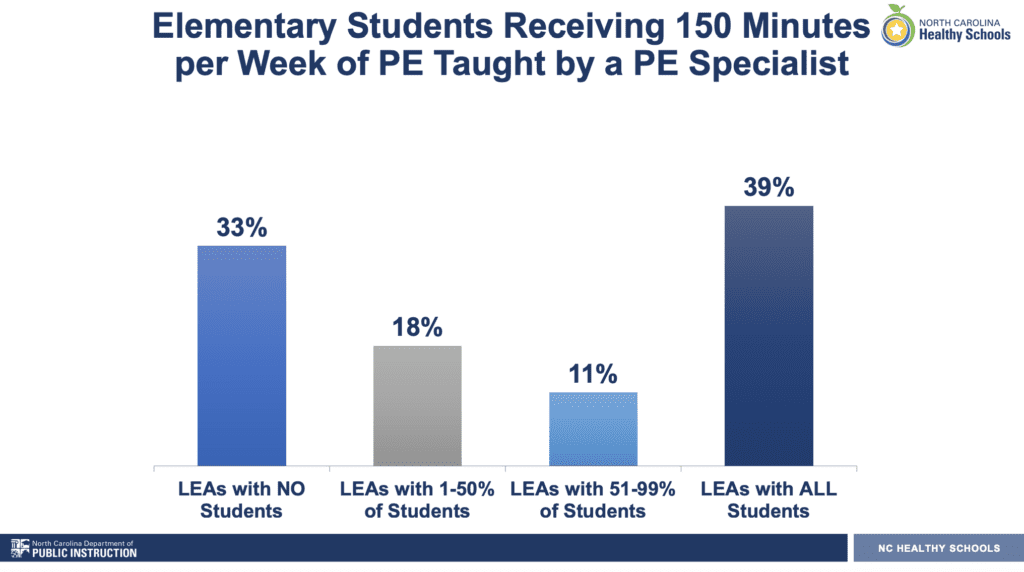

According to the presentation, 98% of district elementary schools said they provide 30 minutes of “daily moderate to vigorous phrasal activity.” The most common methods to provide physical activity include recess and physical education.
Only 81% of districts said their middle schools provided that level of physical activity.
Finally, 96% of districts said none of their schools or teachers withheld recess as a punishment for students — down slightly from 99% of districts in 2023.
Ellen Essick, section chief for DPI’s NC Healthy Schools, told the Board that data on physical activity is important not just for physical health, but for mental health.
In a June press release about the 2023 NC Youth Risk Behavior Survey, DPI linked gains in mental health with students becoming more physically active.
Over the last 10 years, DPI’s survey data show that the more that students report that they are physically active five or more days a week, the less likely they are to report they are sad or hopeless.
Essick said in June that “the positive effect of exercise on mental health is well documented.”
DPI’s presentation also touched on employee wellness programs, which was the largest area districts said they needed more support for.

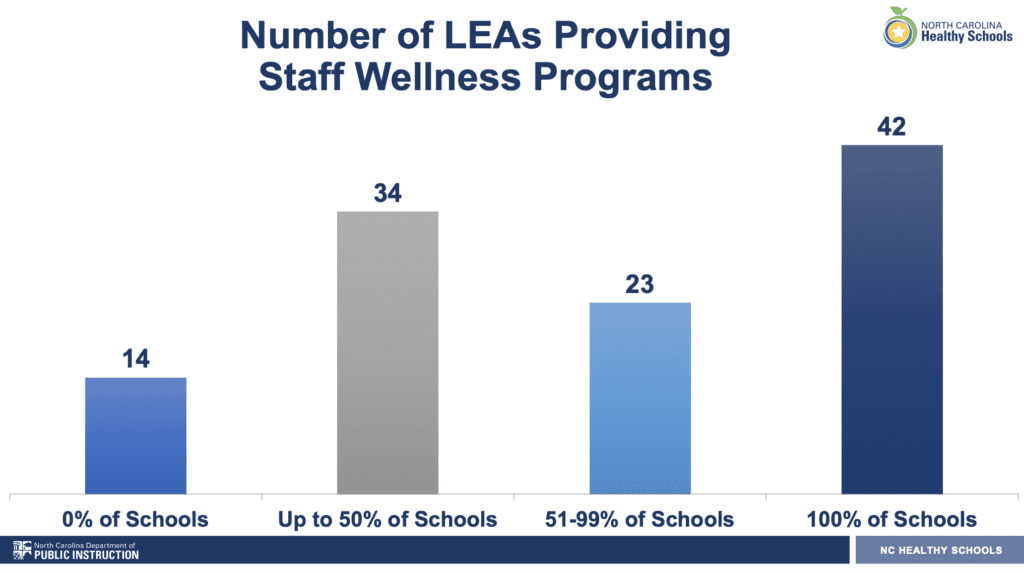
Finally, DPI briefly presented on its annual report to the General Assembly on school-based mental health plans. In 2020, the General Assembly passed legislation requiring school districts to submit the content of their school-based mental health plan by Sept. 15 each year, including their mental health training program and suicide risk referral protocol.
Here’s a look at highlights from DPI’s presentation.
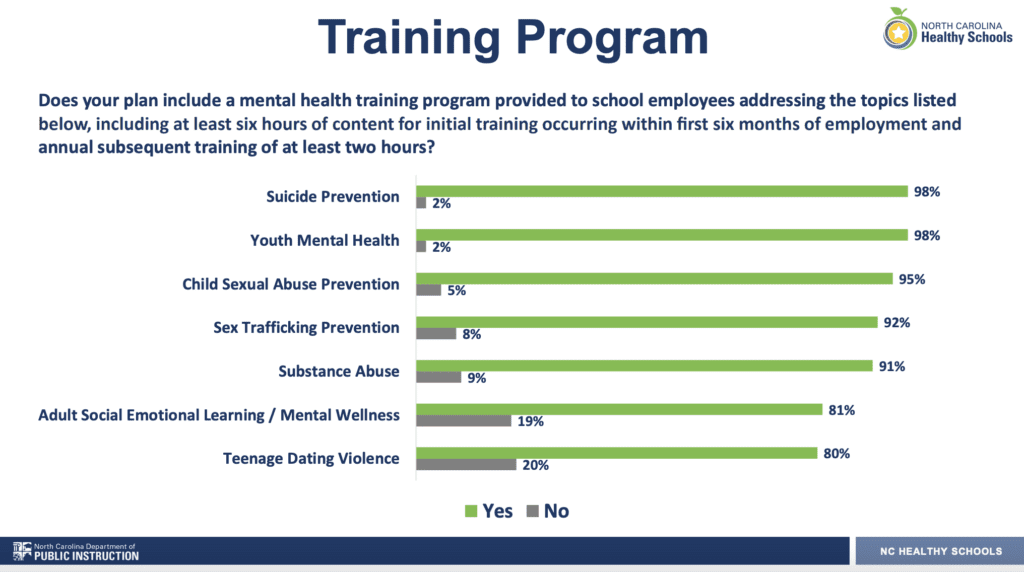

You can read the full report here.
Language arts standards, English learners, and more
- On Wednesday, DPI discussed potential overhauls to how North Carolina teaches language arts. The first draft of new K-12 English/Language Arts Standards were released for public comment last week. The draft new standards include a number of significant changes, including reducing the number of standards and revising English IV offerings for high school seniors.
- The Board approved several changes making it easier for students identified as English Learners to move out of that classification, based on English language proficiency in reading, writing, speaking, and listening skills. There are 178,688 English learners in North Carolina schools, according a new headcount report, reflecting an increase of nearly 16,000 students in the last year.
- The Board also a report to the General Assembly on broadening successful participation to advanced courses for North Carolina students. During the 2024-2025 school year, 97,317 students are enrolled in at least one Advanced Placement (AP) course, per the report. This is a 30% increase in enrollment since the first year of the legislation, in 2014.
- According to the Education of Children in Private Psychiatric Residential Treatment Facilities (PRTFs) report received by the Board last week, North Carolina served 799 students in PRTFs during the 2023-24 fiscal year. The average length of stay was 227 days.
- Finally, in recognition of the impact of Hurricane Helene on western North Carolina, for the 2024-2025 school year only, the Board approved a modification to a graduation policy for students with disabilities participating on the Occupational Course of Study. This modification allows students to satisfy work hours through a combination of disaster relief and recovery efforts.
The full Board meets next on Jan. 8-9, with Green as the newly sworn-in superintendent.



